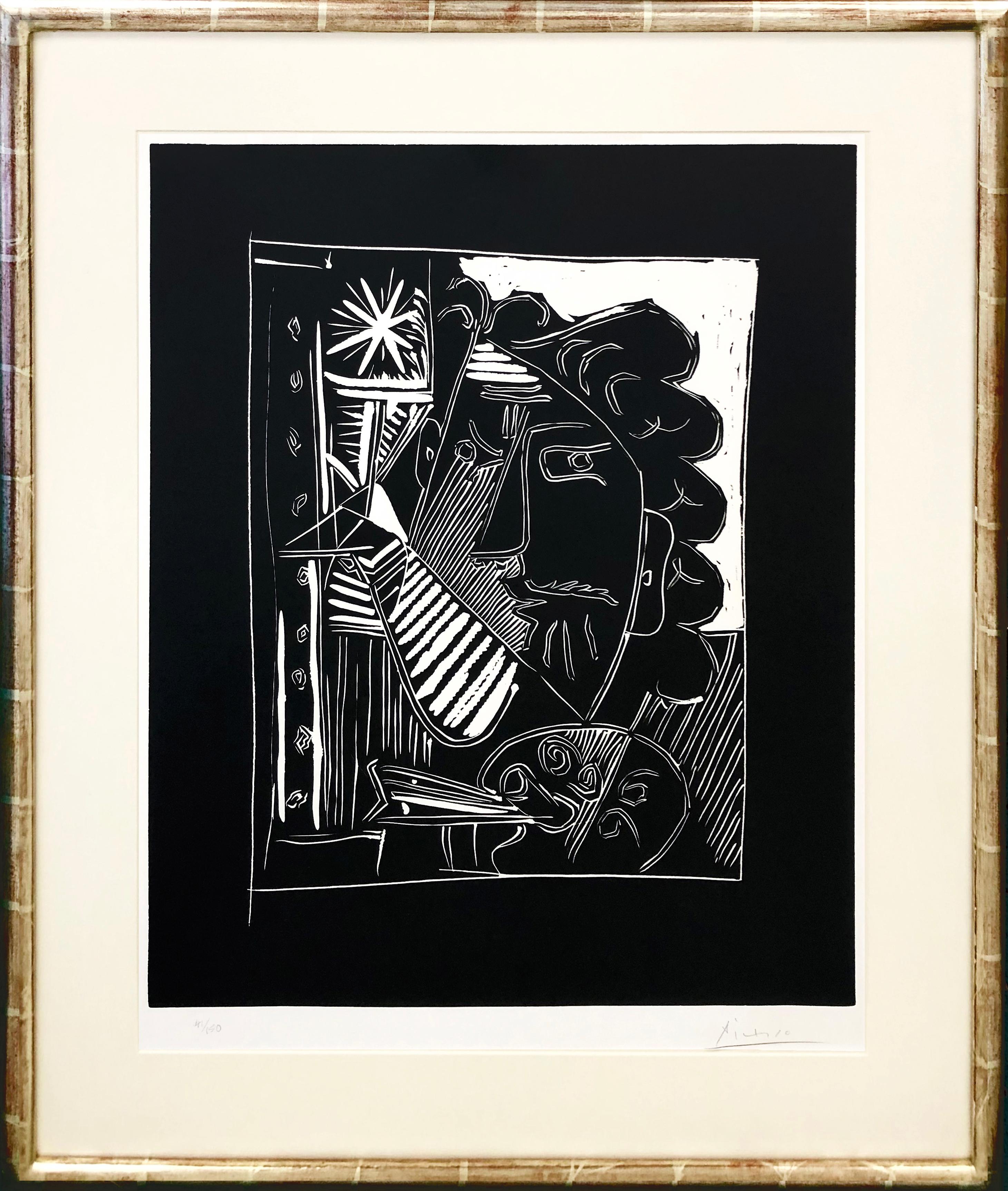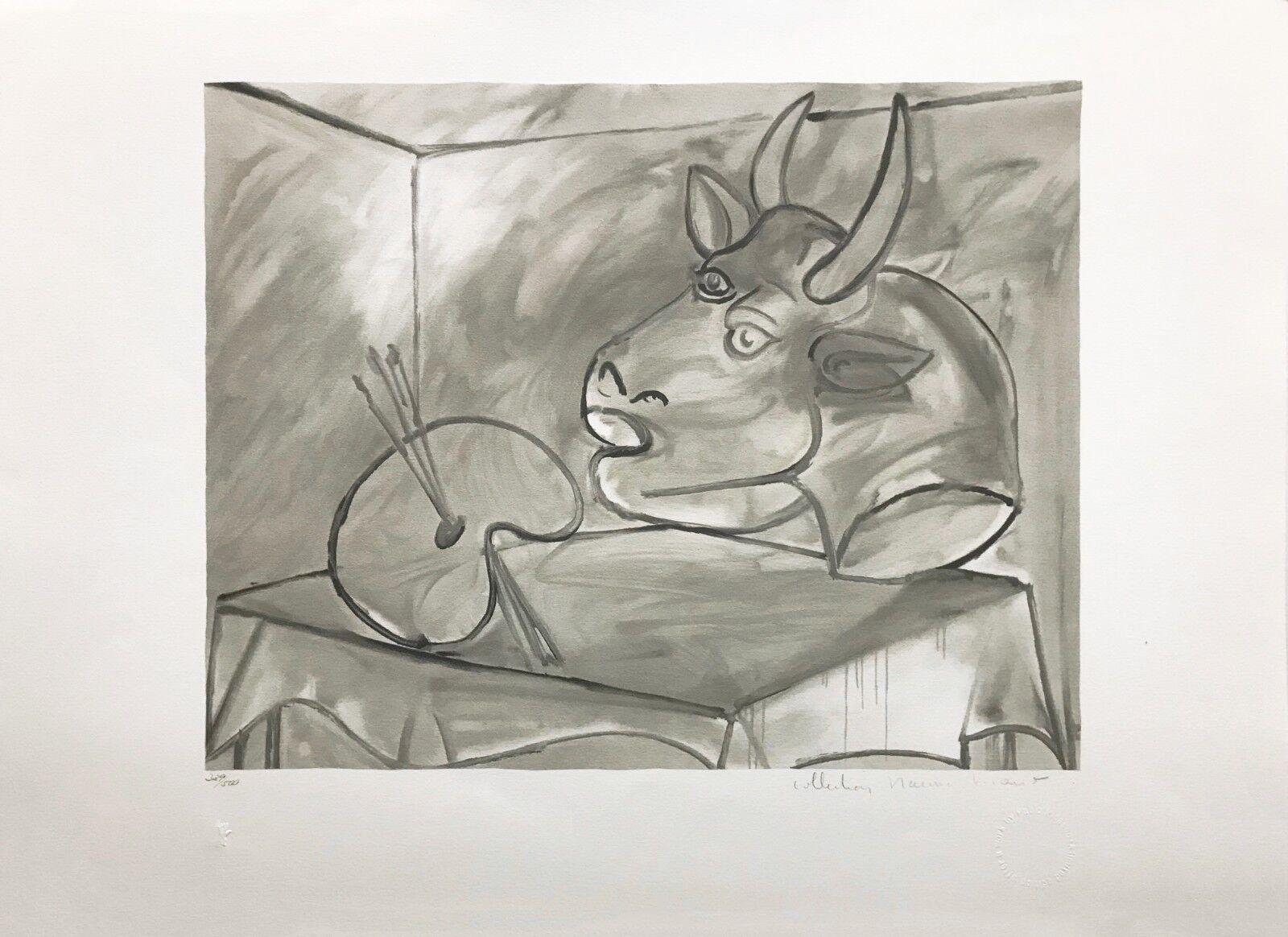Items Similar to MINOTAURE AVEUGLE CONDUIT PAR UNE PETITE FILLE
Want more images or videos?
Request additional images or videos from the seller
1 of 7
(after) Pablo PicassoMINOTAURE AVEUGLE CONDUIT PAR UNE PETITE FILLE1982
1982
About the Item
Selected from the personal collection inherited by Marina Picasso, Pablo Picasso's granddaughter. After Pablo Picasso's death, his granddaughter Marina authorized the printing of these original lithographs which have come to be known as the Picasso Estate Collection The lithographs were meticulously created after the original works oil paintings watercolors pastels and charcoal drawings by Master Chromist Marcel Salinas who worked closely with Picasso in his lifetime.
Lithograph on Arches paper. Hand signed and numbered by Marina Picasso. Picasso estate blind stamp front lower margin. 'Approved by the heirs of Pablo Picasso' ink stamp on verso. Sheet size 21.75 x 29.75 inches. Image size 13.25 x 19.75 inches.
From the edition of 500. Please note our gallery has more than 1 of this artwork in stock and the exact edition number you may receive may be different than pictured.
Artwork is in excellent condition. Gallery issued certificate of authenticity included. All reasonable offers will be considered.
About the Artist: Pablo Picasso (Spanish, 1881–1973) was one of the most influential artists of the 20th century. Picasso melded forms he saw in African sculpture with the multiple perspectives he gleaned from Paul Cezanne, to produce Cubism. Not limited to painting, the artist also expressed himself through collage, sculpture, and ceramics. The artist was prolific up until his death on April 8, 1973 in Mougins, France. Today, his works are held in the collections of The Museum of Modern Art in New York, the Tate Gallery in London, the Hermitage Museum in St. Petersburg, as well as institutions devoted solely to his life work, such as the Museo Picasso Málaga, the Museu Picasso in Barcelona, and the Musée National Picasso in Paris.
- Creator:(after) Pablo Picasso (1881 - 1973, Spanish)
- Creation Year:1982
- Dimensions:Height: 21.75 in (55.25 cm)Width: 29.75 in (75.57 cm)
- Medium:
- Movement & Style:
- Period:
- Framing:Framing Options Available
- Condition:
- Gallery Location:Aventura, FL
- Reference Number:1stDibs: LU725310920722
About the Seller
4.9
Platinum Seller
These expertly vetted sellers are 1stDibs' most experienced sellers and are rated highest by our customers.
Established in 1990
1stDibs seller since 2017
832 sales on 1stDibs
Typical response time: 6 hours
- ShippingRetrieving quote...Ships From: Aventura, FL
- Return PolicyA return for this item may be initiated within 14 days of delivery.
More From This SellerView All
- NATURE MORTE A LA PALETTE ET A LA TETEBy (after) Pablo PicassoLocated in Aventura, FLSelected from the personal collection inherited by Marina Picasso, Pablo Picasso's granddaughter. After Pablo Picasso's death, his granddaughter Marina authorized the printing of t...Category
1980s Cubist Animal Prints
MaterialsLithograph, Paper
- ETUDES DES MAINS ET COLOMBEBy (after) Pablo PicassoLocated in Aventura, FLSelected from the personal collection inherited by Marina Picasso, Pablo Picasso's granddaughter. After Pablo Picasso's death, his granddaughter Marina authorized the printing of t...Category
1980s Cubist Animal Prints
MaterialsLithograph, Paper
- PIGEONSBy (after) Pablo PicassoLocated in Aventura, FLSelected from the personal collection inherited by Marina Picasso, Pablo Picasso's granddaughter. After Pablo Picasso's death, his granddaughter Marina authorized the printing of t...Category
1980s Cubist Animal Prints
MaterialsPaper, Lithograph
- TAUREAU AILE CONTEMPLE PAR QUATRE ENFANTS (BLOCH 229)By Pablo PicassoLocated in Aventura, FLPlate 13 from La Suite Vollard. Bloch 229. Baer 444. Etching on Montval paper. Signed in pencil, from the edition of 260 (there was also an edition of 50 with larger margins). Printe...Category
1930s Cubist Animal Prints
MaterialsPaper, Engraving
- MAMELOUK ENLEVANT UNE FEMME, ATTAQUE PAR UN MOUSQUETAIRE (BLOCH 1586)By Pablo PicassoLocated in Aventura, FLAquatint on wove paper. Hand signed and numbered by Pablo Picasso. Plate 106, from the serie "347 gravures" (B. 1586; BA. 1602 II B b 1). Published by Galerie Louise Leiris, Paris. ...Category
1960s Cubist Animal Prints
MaterialsPaper, Engraving
- PEINTRE AU TRAVAIL (BLOCH 1157)By Pablo PicassoLocated in Aventura, FLEtching, aquatint, drypoint and scraper, on Rives BFK paper. Hand signed and numbered by Pablo Picasso. Published by Galerie Louise Leiris, Paris. Image size 12.125 x 18.125 inches. ...Category
1930s Cubist Animal Prints
MaterialsDrypoint, Paper, Aquatint, Engraving
You May Also Like
- After Georges Braque - Antiborée - LithographLocated in Collonge Bellerive, Geneve, CHLithograph after Georges Braque. Signed in the plate Edition of 150 Dimensions: 76 x 117 cm Bibliography: « Les Métamorphoses de Braque» of Heger de Loewenfeld and Raphaël de Cuttoli , Editions FAC, Paris, 1989. In 1961 Georges Braque decided with his laidary friend Heger de Loewenfeld to pick up certain of his works to in order to create artworks, this beautiful litograph is one of them. Héméra in the Mythology: In Greek mythology Hemera was the personification of day and one of the Greek primordial deities. She is the goddess of the daytime and, according to Hesiod, the daughter of Erebus and Nyx (the goddess of night). Hemera is remarked upon in Cicero's De Natura Deorum, where it is logically determined that Dies (Hemera) must be a god, if Uranus is a god. The poet Bacchylides states that Nyx and Chronos are the parents, but Hyginus in his preface to the Fabulae mentions Chaos as the mother/father and Nyx as her sister. She was the female counterpart of her brother and consort, Aether (Light), but neither of them figured actively in myth or cult. Hyginus lists their children as Uranus, Gaia, and Thalassa (the primordial sea goddess), while Hesiod only lists Thalassa as their child. The father of Cubism Three Cubist that distinguishes art historian periods were initiated and developed by Georges Braque: The Cubist Cézanne (1907-1909), Executive (1909-1912) and synthetic (1912-1922). Post-Impressionist and fawn, Braque no longer adheres to the contingency of a decorative way or the other. Cézanne’s paintings exhibited at the Grand Palais during the retrospective of 1907 are a revelation: Cézanne sought and invented a pictorial language. In his footsteps, Braque went to the South with the reasons of the Master. He returned with Estaque landscapes and surprising Ciotat it keeps Cezanne geometric model and retains the “passages” continuity from one surface to another to create the sensation of “turning around” of the object represented. But he wants to go after the consequences of the vision of Cezanne. In his paintings Houses in L’Estaque (1908) it simplifies the volumes of houses, neglects detail by removing doors and windows: the plastic rhythm that builds the table. Large Nude , a masterpiece of the period, can be considered the first work of Cézanne cubism . Systematizing and deepening Braque discoveries open the door analytical cubism. In 1909, his painting became more cerebral than sensual. The pattern is recreated in the two-dimensionality of the canvas, leaving aside any illusionistic perspective. In Still Life with Violin, objects are analyzed facets according to their characteristic elements, each facet referring to a particular view of the object. There are so many facets of points selected view: Table reflects the knowledge of the object and the ubiquity of the eye. Moreover, Braque is looking for the essence of the objects in the world rather than their contingency, which explains the absence of light source and use of muted colors (gray, ocher), contingent aspects of the object . But formal logic has stepped facets, erased any anecdote to the object and ultimately led to his painting a hermetic more marked on the edge of abstraction (see the series of Castle Roche-Guyon ). Braque, anxious to keep the concrete and refusing at all costs that the logic of Cubism takes the paintings to abstract, reintroduced signs of reality in his paintings in 1912 marks the beginning of Synthetic Cubism. Historians speak of “signs of real” rather than reality because what interests Braque, this is not to put reality into a table, but to create a painting which, by its language, refers to the real. To do this, he invented two major techniques XX th century inclusions and contributions. The inclusions consist of painting objects that have no real depth, materials (wallpaper in Nature morte aux playing cards faux wood is a pictorial inclusion) or letters (calligraphic inclusion in Portuguese ), made first brush and a few months later stencil. Contributions are defined in contrast with the collage on canvas of foreign materials: glued or sand paper, sawdust, etc.. Regarding the collages, Braque used for the first time in September 1912 a piece of adhesive paper imitating faux wood Compote...Category
1950s Cubist Animal Prints
MaterialsLithograph
- Le Singe - Etching by Pablo Picasso - 1940sBy Pablo PicassoLocated in Roma, ITNot Signed. Not Numbered. Edition of 225 pieces. Etching - aquatint. Belongs to the Suite "Histoire Naturelle de Buffon". Catalogue Bloch n.339. Passepartout included.Category
1940s Cubist Figurative Prints
MaterialsEtching, Paper
- La Fille aux OiesBy Jean-Emile LaboureurLocated in New York, NYJean-Emile Laboureur (1877-1943), La Fille aux Oies, engraving, 1916, signed in pencil lower left, numbered (4/40) lower right and inscribed “imp,” also titled lower left margin edge...Category
1910s Cubist Figurative Prints
MaterialsEngraving
- Migration - Etching by Georges Braque - 1962By Georges BraqueLocated in Roma, IT" Migration " is an etching realized by Georges Braque in 1962. The print is hand signed and numbered. This is an edition of 90 prints. Bibliography: D. Vallier, Braque : l'oeuvr...Category
1960s Cubist Animal Prints
MaterialsEtching
- Jeune Tigre jouant avec sa mère (Young Tiger playing with its mother)By Eugène DelacroixLocated in Middletown, NYLithograph on on white wove paper, 4 1/2 x 7 3/8 inches (112 x 187 mm), wide margins. First state (of 6). A very good impression with minor scattered spots of very light discoloration. [Delteil 91.1] __________ At an early age Delacroix became a lover of music and literature and had been drawing from the time he entered school. He expected painting would be a hobby, but on the death of his father he found he had to make his own way in life. In 1817 he entered the studio of Pierre-Narcisse Guerin; amongst his fellow pupils was Gericault. His first exhibited work was Dante and Virgil...Category
Mid-19th Century Barbizon School Animal Prints
MaterialsHandmade Paper, Lithograph
- Faust, Méphistophélès et le Barbet / Faust, Méphistophélès and the Water SpanielBy Eugène DelacroixLocated in Middletown, NYLithograph on Chine appliqué, 9 1/4 x 8 1/8 inches (235 x 206 mm), full margins. First state (of 4). Extremely minor uniform age tone, otherwise in good condition. A superb, richly-inked impression. [Delteil 61.1] ______ At an early age Delacroix became a lover of music and literature and had been drawing from the time he entered school. He expected painting would be a hobby, but on the death of his father he found he had to make his own way in life. In 1817 he entered the studio of Pierre-Narcisse Guerin; amongst his fellow pupils was Gericault. His first exhibited work was Dante and Virgil...Category
Early 19th Century Barbizon School Figurative Prints
MaterialsHandmade Paper, Lithograph
Recently Viewed
View AllMore Ways To Browse
Pablo Oil
Pablo Picasso Oil
Picasso Original Oil
Picasso Ink
Pablo Picasso Ink
Picasso Ceramics Signed
Picasso Prints Animals
Ceramics Prints Picasso
Ceramics By Picasso Prints
Original Paul Cezanne
Cubist Collage French
Oil Paintings Of Animals By African Artists
Picasso Animal Print Original
Retro Picture Collage
Malaga Oil
Cubist Charcoal Drawing
Picasso Watercolor Signed And Numbered Print
Cubism Oil Pastel





